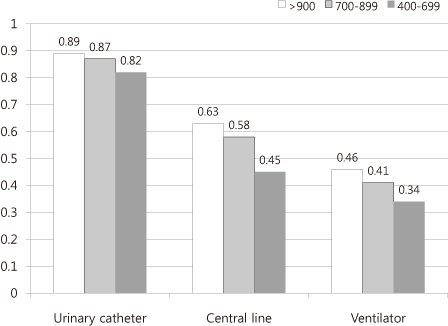Hanyang Med Rev.
2011 Aug;31(3):135-140. 10.7599/hmr.2011.31.3.135.
Current Status of Healthcare-associated Infections in Korea
- Affiliations
-
- 1Department of Laboratory Medicine, Seoul National University College of Medicine, Seoul, Korea. euichong@snu.ac.kr
- KMID: 2168190
- DOI: http://doi.org/10.7599/hmr.2011.31.3.135
Abstract
- In this article, the annual reports of the Korean Nosocomial Infections Surveillance System (KONIS) were referred for the description of the current status of healthcare-associated infections (HAI) in Korea. KONIS has been established with the cooperation of the Korean Society for Nosocomial Infection Control and the Korea Centers for Disease Control and Prevention since 2006. The KONIS surveillance of healthcare-associated infections at intensive care units (ICU) and surgical site infections was performed by 116 ICUs of 63 hospitals in 2009. According to the 2010 report of KONIS, the infection rate per 1,000 patient-days in ICU is 7.65. The device-associated infection rates of bloodstream infection, urinary tract infection, and pneumonia are 3.27, 4.80, and 1.86, respectively. Surgical site infection (SSI) rates of gastric surgery, colon surgery, rectal surgery, craniotomy, ventricular shunt and spinal fusion are 3.3%, 4.7%, 5.8%, 3.6%, 5.1% and 3.9%, respectively. The SSI rates of gastrectomy and knee prosthesis are over 90 percentiles of the data of National Healthcare Safety Network, USA. In conclusion, the current healthcare-associated infection rates are higher than those of other developed countries. Through the harmonized communication of various specialists such as infectious diseases physicians, clinical microbiologists, and infection control nurses, the HAI should be monitored and prevented.
MeSH Terms
Figure
Cited by 1 articles
-
Improving patient safety through prevention of healthcare associated infections
Shin-Woo Kim
J Korean Med Assoc. 2015;58(2):116-122. doi: 10.5124/jkma.2015.58.2.116.
Reference
-
1. Kim EC. Korean Society for Nosocomical Infection Control. Healthcare-associated infection and infection control. Infection control and prevention in healthcare facilities. 2011. 4th ed. Seoul: Hanmibook;3–8.2. Edmond MB, Wenzel RP. Mandell GL, Douglas RG, Bennett JE, editors. Organization for infection control. Mandell, Douglas, and Bennett's principles and practice of infectious diseases. 2010. 7th ed. Philadelphia: Churchill Livingstone;3669–3672.
Article3. Kwak Y, Cho YK, Kim JY, Kim HY, Kim YK, Kim ES, et al. Korean nosocomial infections surveillance system, intensive care unit module report: data summary from July 2009 through June 2010 and analysis of 4-year results. Korean J Nosocomial Infect Control. 2011. 16:S7–S13.4. Haley RW, Culver DH, White JW, Morgan WM, Emori TG, Munn VP, et al. The efficacy of infection surveillance and control programs in preventing nosocomial infections in US hospitals. Am J Epidemiol. 1985. 121:182–205.
Article5. O'Boyle C, Jackson M, Henly SJ. Staffing requirements for infection control programs in US health care facilities: Delphi project. Am J Infect Control. 2002. 30:321–333.6. Kwak YG, Cho YK, Kim JY, Lee SO, Kim HY, Kim YK, et al. Korean nosocomial infections surveillance system, intensive care unit module report: data summary from July 2008 through June 2009 and analysis of 3-year results. Korean J Nosocomial Infect Control. 2010. 15:14–25.7. Korea Centers for Disease Control and Prevention. 2011. The 7th symposium for healthcare-associated infection and antimicrobial resistance. 2011 Apr 21; Seoul: KCDC;13.8. Dudeck MA, Horan TC, Peterson KD, Allen-Bridson K, Morrell GC, Pollock DA, et al. National Healthcare Safety Network (NHSN) report, data summary for 2009, deviceassociated module. Am J Infect Control. 2011. 39:349–367.
Article9. Kim YK, Kim HY, Kim ES, Kim HB, Uh Y, Jung SY, et al. The Korean surgical site infection surveillance system report, 2009. Korean J Nosocomial Infect Control. 2010. 15:1–13.10. Kim HY. Korean nosocomial infections surveillance system of surgical site infections. Korean J Nosocomial Infect Control. 2011. 16:S14–S22.11. Edwards JR, Peterson KD, Mu Y, Banerjee S, Allen-Bridson K, Morrell G, et al. National Healthcare Safety Network (NHSN) report: data summary for 2006 through 2008, issued December 2009. Am J Infect Control. 2009. 37:783–805.
Article
- Full Text Links
- Actions
-
Cited
- CITED
-
- Close
- Share
- Similar articles
-
- Current Status and Issues of Infection Control in the Neonatal Intensive Care Units
- Infection Control for Healthcare-Associated Infections in Pediatric Patients
- Multidrug-resistant Organisms and Healthcare-associated Infections
- Prevention and treatment of healthcare-associated infections
- Current Status of the Estimation on the Number of People Who Living with HIV and the Rate of Undiagnosed Cases




